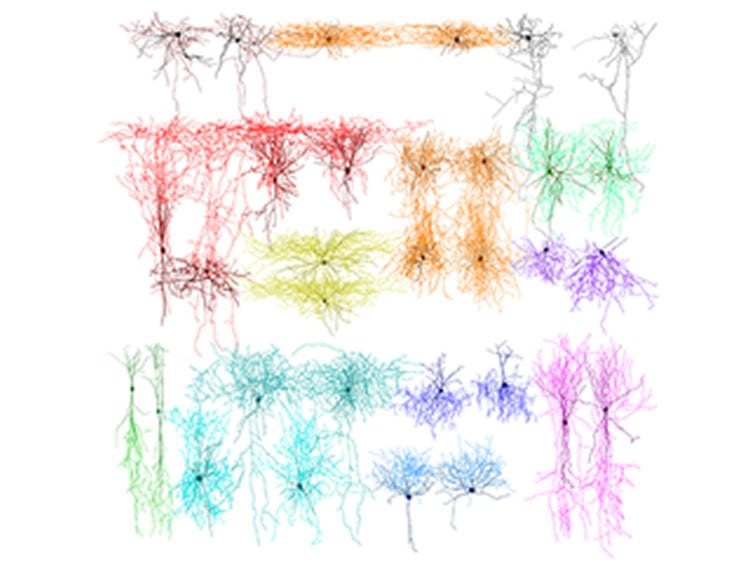Our brains contain billions of neurons linked through trillions of synaptic connections, and although disentangling this wiring may seem like mission impossible, a research team from Baylor College of Medicine took on the task. Researchers worked to decipher the wiring of the mouse neocortex, the outermost part of the brain that is thought to be responsible for cognition and perception.
Their hope was that this complex wiring could be broken down to a set of rules governing the assembly of neocortical networks. Their findings, which appear in the current edition of Science, show that the basic wiring of the local circuitry of the neocortex can indeed be captured using a few connectivity rules that are recycled across the layers of the neocortex.
“To our knowledge this is the most comprehensive study ever attempted to map out the canonical circuit diagram of the mature neocortex,” said Dr. Xiaolong Jiang, assistant professor of neuroscience at Baylor College of Medicine and first author on the study. “We were able to determine the cell types found in the neocortex and create a wiring diagram of its local circuit.”
Using cutting-edge methods for tissue slicing and a novel protocol to recover the morphology of neurons, Jiang, working in Andreas Tolias’ lab at Baylor, and his colleagues identified 15 types of inhibitory neurons (the neurons that inhibit electrical firing in brain circuits). Using simultaneous multiple whole-cell recordings they also characterized their electrophysiological properties and mapped the connectivity diagram between them, and also how they connect with nearby excitatory neurons.
“We tested more than 11,000 pairs of connections between morphologically classified neurons and discovered three general principles that govern the connections between them,” Jiang said.
First, there are two types of neurons that inhibit all other types neurons in the local network – the master regulators. Second, certain types of inhibitory neurons connect very selectively and shut down only some interneuron types and notably do not communicate with excitatory cells. The third principle involved many inhibitory neuron types that preferentially inhibited their own type and also connected with excitatory neurons.
“We found that these principles could be seen across different layers of the neocortex,” said Dr. Andreas Tolias, associate professor of neuroscience at Baylor and a lead author on the study.

“Our finding that the complex cortical connectivity can be broken down into a small number of wiring rules may provide a critical stepping stone that can lead to a breakthrough in discovering the canonical algorithm(s) implemented by the local cortical circuit (cortical column) and help ultimately understand how the brain computes.”
In addition, the researchers hope that given that many neuropsychiatric diseases such as autism spectrum disorders and epilepsy may be associated with specific cell-type wiring abnormalities, the detailed connectivity map of cortical circuit they provide could serve as a powerful blueprint to pinpoint specific circuit problems in animal models of diseases. They hope that this approach will provide a path forward to develop more cell-type specific interventions for these devastating diseases.
Others who took part in this study include Shan Shen, Cathryn R. Cadwell, Favian Sinz and Saumil Patel, all with Baylor College of Medicine; Philipp Berens, with Baylor and the University of Tübingen in Germany; and Alexander S. Ecker with Baylor, University of Tübingen and Max Planck Institute for Biological Cybernetics.
Funding: This work was supported by grants DP1EY023176, DP1OD008301 and R21EB016223 to A.S.T.; the McKnight Scholar Award to A.S.T.; the Arnold and Mabel Beckman Foundation Young Investigator Award to A.S.T.; P30EY002520, T32EY07001; the Deutsche Forschungsgemeinschaft (DFG, EXC 307), and the German Federal Ministry of Education and Research (BMBF; BCCN Tübingen, FKZ 01GQ1002). C.R.C. is supported by F30MH095440, T32GM007330, and T32EB006350.
Source: Graciela Gutierrez – Baylor University
Image Source: The image is adapted from the Baylor University press release.
Original Research: Abstract for “Principles of connectivity among morphologically defined cell types in adult neocortex” by Xiaolong Jiang, Shan Shen, Cathryn R. Cadwell, Philipp Berens, Fabian Sinz, Alexander S. Ecker, Saumil Patel, and Andreas S. Tolias in Science. Published online November 27 2015 doi:10.1126/science.aac9462






